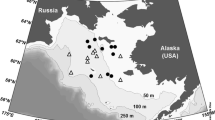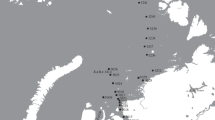Abstract
We report on the first record of interstitial cnidarians in sea ice. Ice core samples were collected during eight field periods between February 2003 and June 2006 in the coastal fast ice off Barrow, Alaska (71°N, 156°W) at four locations. A total of 194 solitary, small (0.2–1.1 mm) elongated specimens of a previously unknown interstitial hydroid taxon were found. By cnidome composition and the occurrence of a highly retractable pedal disc formed by epidermal tissue only, the specimens are tentatively assigned to representatives of the family Protohydridae, subclass Anthomedusae. The hydroids were found almost exclusively in the bottom 10 cm-layer (at the ice–water interface) of 118 ice cores, with abundances ranging from 0 to 27 individuals per core section (0–4,244 ind m−2) and a grand mean of 269 ind m−2 in bottom 10 cm-layer sections. Abundances were lower in December and late May than in months in between with considerable site variability. A factor analysis using 12 variables showed that hydroid abundance correlated highest with abundances of copepod nauplii and polychaete juveniles suggesting a trophic relationship.



Similar content being viewed by others
References
Arar EJ, Collins GB (1992) In vitro determination of chlorophyll a and phaeophytin a in marine and freshwater by fluorescence. EPA Method 445.0
Arlt G (1973) On the importance of biological production of the meiofauna in coastal waters. Wissensch Zeitschrift Univ Rostock 22:1141–1145 (in German)
Bouillon J, Grohmann PA (1990) Pinushydra chiquitita gen. et sp. nov. (Cnidaria, Hydrozoa, Athecata), a solitary marine mesopsammic polyp. Cah Biol Mar 31:291–305
Bozhenova OV, Stepanjants SD, Sheremetevsky AM (1989) The first finding of the meiobenthic cnidaria Boreohydra simplex (Hydrozoa, Athecata) in the White Sea. Zool Zh 68:11–16 (in Russian)
Carey AG (1985) Marine ice fauna: Arctic. In: Horner R (ed) Sea ice biota. CRC, Boca Raton, pp 173–190
Carey AG Jr (1992) The ice fauna in the shallow southwestern Beaufort Sea, Arctic Ocean. J Mar Syst 3:225–236
Eicken H (2003) From the microscopic, to the macroscopic, to the regional scale: growth, microstructure and properties of sea ice. In: Thomas DN, Dieckmann GS (eds) Sea ice: an introduction to its physics, biology, chemistry, and geology. Blackwell, Oxford, pp 22–81
Feder HM, Paul AJ (1980) Seasonal trends in meiofaunal abundance on two beaches in Port Valdez, Alaska. Syesis 13:27–36
van Gaever S, Moodley L, de Beer D, Vanreusel A (2006) Meiobenthos at the Arctic Håkon Mosby Mud Vulcano, with a parental-caring nematode thriving in sulphide-rich sediments. Mar Ecol Prog Ser 321:143–155
Garrison DL, Buck KR (1986) Organism losses during ice melting: a serious bias in sea ice community studies. Polar Biol 6:237–239
Gayraud S, Philippe M (2003) Influence of bed-sediment features on the interstitial habitat available for macroinvertebrates in 15 French streams. Internat Rev Hydrobiol 88:77–93
Giere O (1993) Meiobenthology: the microscopic fauna in aquatic sediments. Springer, Berlin
Gradinger R (1999a) Vertical fine structure of algal biomass and composition in Arctic pack ice. Mar Biol 133:745–754
Gradinger R (1999b) Integrated abundances and biomass of sympagic meiofauna from Arctic and Antarctic pack ice. Polar Biol 22:169–177
Gradinger R (2002) Sea ice microorganisms. In: Bitten G (ed) Encyclopedia of environmental microbiology. Wiley, New York, pp 2833–2844
Gradinger R, Bluhm BA (2005) Susceptibility of sea ice biota to disturbances in the shallow Beaufort Sea. Phase 1: Biological coupling of sea ice with the pelagic and benthic realms. Final report OCS study MMS 2005–062
Gradinger R, Meiners K, Plumley G, Zhang Q, Bluhm BA (2005) Abundance and composition of the sea ice meiofauna in off-shore pack ice of the Beaufort Gyre in summer 2002 and 2003. Polar Biol 28:171–181
Grainger EH, Hsiao SIC (1990) Trophic relationships of the sea ice meiofauna in Frobisher Bay, Arctic Canada. Polar Biol 10:283–292
Heip C (1971) The succession of benthic micrometazoans in a brackish water habitat. Biologisch Jaarboek 39:191–196
Heip C, Smol N (1976) On the importance of Protohydra leuckerti as a predator of meiobenthic populations. In: Persoone G, Jaspers E (eds) Proceedings of the 10th european marine biology symposium, 2: population dynamics of marine organisms in relation with nutrient cycling in shallow waters. University Press, Wetteren, Belgium, pp 285–296
Horner R (1985) Sea ice biota. CRC, Boca Raton
Junge K, Eicken H, Deming JW (2003) Bacterial activity at −2 to −20°C in Arctic wintertime sea ice. Appl Env Microbiol 70:550–557
Karayanni H (2004) Evaluation of double formalin-Lugol’s fixation in assessing number and biomass of ciliates: an example of estimations at mesoscale in NE Atlantic. J Microbiol Methods 56:349–358
Karl DM, Winn CD, Hebel DVW, Letelier R (1990) JGOFS Hawaii Ocean Time-series program field and laboratory protocols. http://www.hahana.soest.hawaii.edu/hot/protocols/protocols.html, Hawaii
Krembs C, Gradinger R, Spindler M (2000) Implications of brine channel geometry and surface area for the interaction of sympagic organisms in Arctic sea ice. J Exp Mar Biol Ecol 243:55–80
Lampitt RS, Billett DSM, Rice AL (1986) Biomass of the invertebrate megabenthos from 500–4100 m in the northeast Atlantic Ocean. Mar Biol 93:69–81
Lee HJ, Gerdes D, Vanhove S, Vincx M (2001) Meiofauna response to iceberg disturbance on the Antarctic continental shelf at Kapp Norvegia (Weddell Sea). Polar Biol 24:926–933
Light B, Maykut GA, Grenfell TC (2003) Effects of temperature on the microstructure of first-year Arctic sea ice. J Geophys Res 108. doi:10.1029/2001JC000887
Melnikov I (1997) The Arctic sea ice ecosystem. Gordon and Breach Science, Australia
Michel C, Nielsen TG, Nozais C, Gosselin M (2002) Significance of sedimentation and grazing by ice micro- and meiofauna for carbon cycling in annual sea ice (northern Baffin Bay). Aquat Microb Ecol 30:57–68
Norenburg JL, Morse MP (1983) Systematic implications of Euphysa ruthae n. sp. (Athecata: Corymorphidae), a psammophilic solitary hydroid with unusual morphogensis. Trans Am Microsc Soc 102:1–17
Nozais C, Gosselin M, Michel C, Tita G (2001) Abundance, biomass, composition and grazing impact of the sea-ice meiofauna in the North Water, northern Baffin Bay. Mar Ecol Prog Ser 217:235–250
Pati AC, Belmonte G, Ceccherelli VU, Boero F (1999) The inactive temporary component: an unexplored fraction of meiobenthos. Mar Biol 134:410–427
Pfannkuche O, Thiel H (1987) Meiobenthic stocks and benthic activity on the NE-Svalbard shelf and in the Nansen Basin. Polar Biol 7:253–266
Remane A (1927) Halammohydra, ein eigenartiges Hydrozoon der Nord- und Ostsee. Z Morph Oekol Tiere 7:82–92 (in German)
Salvini-Plawen Lv (1987) Mesopsammic cnidaria from plymouth (with systematic notes). J Mar Biol Assoc UK 67:623–637
Schewe I (2001) Small-sized benthic organisms of the Alpha Ridge, central Arctic Ocean. Internat Rev Hydrobiol 86:317–335
Schuenemann H, Werner I (2005) Seasonal variations in distribution patterns of sympagic meiofauna in Arctic pack ice. Mar Biol 146:1091–1102
Schultz E (1950a) Psammohydra nanna, ein neues solitäres Hyrozoon der westlichen Beltsee. Kieler Meeresforsch 7:122–127 (in German)
Schultz E (1950b) Zur Ökologie von Protohydra leuckarti Greef. Kieler Meeresforsch 7:128–136 (in German)
Sommer S, Pfannkuche O (2000) Metazoan meiofauna of the deep Arabian Sea: standing stocks, size spectra and regional variability in relation to monsoon induced enhanced sedimentation regimes of particulate organic matter. Deep-Sea Res II 47:2957–2977
Thiel H (1988) Chapter 19: Cnidaria. In: Higgins RP, Thiel H (eds) Introduction to the study of meiofauna. Smithsonian Institution Press, Washington DC, pp 266–272
Vanaverbeke J, Soetaert K, Heip C, Vanreusel A (1997) The metazoan meiobenthos along the continental slope of the Globan Spur (NE Atlantic). J Sea Res 38:93–107
Weissenberger J, Dieckmann G, Gradinger R, Spindler M (1992) Sea ice: a cast technique to examine and analyze brine pockets and channel structure. Limnol Oceanogr 37:179–183
Acknowledgments
The results reported here are part of studies supported by the National Science Foundation (OPP 0520566) and the Coastal Marine Institute (Task Order 85242). SP’s work on hydroid biodiversity is supported by the Italian Ministry for University and Research, the MarBEF network and the Province Administration of Lecce. We thank the director and logistics staff of the Barrow Arctic Science Consortium for their continuous logistical support during field operations. We are grateful to S. Story-Manes and M. Nielson-Kaufman for their support while in Barrow. Three reviewers are thanked for improving a previous manuscript draft. This article contributes to the Arctic Ocean Diversity Census of Marine Life project.
Author information
Authors and Affiliations
Corresponding author
Rights and permissions
About this article
Cite this article
Bluhm, B.A., Gradinger, R. & Piraino, S. First record of sympagic hydroids (Hydrozoa, Cnidaria) in Arctic coastal fast ice. Polar Biol 30, 1557–1563 (2007). https://doi.org/10.1007/s00300-007-0316-9
Received:
Revised:
Accepted:
Published:
Issue Date:
DOI: https://doi.org/10.1007/s00300-007-0316-9




